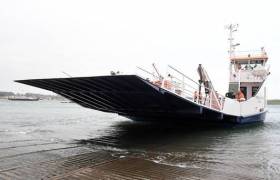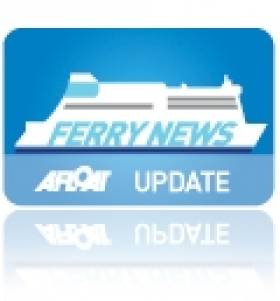Displaying items by tag: New Strangford Ferry
#Old&New – Fresh from annual dry-docking is Isle of Inishmore of Irish Ferries, that recently resumed Rosslare-Pembroke duties, writes Jehan Ashmore.
The 34,000 gross tonnage cruiseferry had undergone routine maintenance work at A&P Falmouth, Cornwall. This year marks 20 years since Isle of Inishmore made a debut in 1997 for owners, Irish Continental Group. The custom built ship firstly began operations for ICG's ferry division on the Dublin-Holyhead route.
Built by Van der Giessen-de-Noord, Krimpen aan den Ijssel, Rotterdam, Isle of Inishmore carries 2,200 passengers. This makes the cruiseferry still one of the largest in terms of capacity in northern-western Europe. In fact she carries more than that of flagship Ulysses of 1,875, though the larger 50,000 gross tonnage giant carries more cars and trucks.
Last month Isle of Inishmore had relieved Ulysses on the Dublin-Holyhead route, which saw the flagship drydock instead at Cammell Laird, Birkenhead. Currently at the Merserside facility is fastferry Jonathan Swift following completion of similar work. The craft having vacated the dry-dock shifted to the nearby wet basin.
Aside shiprepairs, Cammell Laird also build vessels including the £6.2m newbuild, Strangford II which was completed last year for the Department for Infrastructure (DfI) in Northern Ireland. In recent days reports the Belfast Telegraph, the 28 vehicle ferry finally began service on Strangford Lough following teething problems with vehicle loading ramps as previously reported.
As for Isle of Inishmore’s return to the ferry scene at Rosslare Europort (see report: Irish Rail 30th) this led to relief cruiseferry Oscar Wilde head also for Cornwall. An overhaul of the eldest fleetmember at the south-west UK shipyard will be carried out prior to taking up seasonal service to Cherbourg, France that begins on 1 March.
The fifth member of Irish Ferries fleet, the chartered-in ropax, Epsilon has in recent weeks carried out freight-only runs between Dublin and Rosslare. They have taken place in between routine rosters on weekly Dublin-Holyhead sailings. In addition the Italian flagged ropax sailings on the year-round operated Irish capital-continent connection to Cherbourg.
This morning Epsilon docked at the Normandy port. At the same time French service rival, Stena Line (albeit serving out of Rosslare) saw relief ropax Stena Nordica also make an in-bound call.
New Strangford Lough Car Ferry to Make Autumn Debut
#NewbuildFerry - A new £6m double ended carferry for Strangford Lough, Northern Ireland as previously reported is due to enter service this autumn, writes Jehan Ashmore.
The Department for Infrastructure (DfI) has established a project for the delivery of two ferries – one for the Ballycastle, Co. Antrim to Rathlin Island ferry launched last week by Arklow Marine Services. The second ferry is for the Strangford Lough Ferry Service, following a contract from the DFI for the 28 vehicle/260 passenger newbuild was awarded to Cammell Laird, Birkenhead.
When in service, the new ferry named MV Strangford II will alternate with MV Portaferry II to service the route between Strangford and Portaferry, Co. Down. The 10 minute service is operated on a half-hourly schedule.
The DFI has responded to Afloat.ie on what awaits the fate of MV Strangford (built in 1969 by Verolme Dockyard, Cork) and the passenger only MV Rachlyn. The DFI commented that they have engaged the Disposal Services Authority (DSA) to arrange disposal of both vessels, which will no longer be required when the new replacement ferry, Strangford II comes into operation.
The DSA has invited expressions of interest to arrive by 13 October and it is anticipated that the vessels will be sold later this year.
Cammell Laird Secure Contract to Build New Strangford Lough Ferry
#NewPortaFERRY – Cammell Laird, the Birkenhead based marine and specialist engineering company has been awarded a £5.7m project by the Northern Ireland's Department for Regional Development.
The news follows an open procurement exercise which attracted interest from shipyards across Europe.
The contract will see the firm construct a new car and passenger ferry to replace the MV Strangford operating the Strangford-Portaferry service on The Narrows at the entrance of Strangford Lough in Co. Down. The new ferry is due to be delivered by August 2016.
Mr Rob McBurney, Commercial Director of Cammell Laird, said: "We are very pleased to have been awarded the contract for the construction of the new Strangford Ferry. The company has a long tradition of ship building and we look forward to working with the Department over the coming years."
The new ferry will have capacity for 28 cars and 260 passengers and will share the ferry operation on a rotational basis with the MV Portaferry II. This will provide improved capacity and remove the need for a 7.5 tonne weight restriction that is in place when the MV Strangford is in service.
Transport Minister Danny Kennedy said: "The new ferry will replace the existing MV Strangford with a new modern ferry that has been designed specifically for this service. The new ferry will be built over the next 18 months and, when it comes into operation, will provide a more reliable and efficient ferry service.
"The Department for Regional Development currently operates a vehicle ferry service in Strangford Lough between Strangford and Portaferry with two vehicle ferries and a back-up passenger ferry. The new ferry will replace the existing MV Strangford which is over 40 years old and is approaching the end of its economically operational life."
The Department has engaged with a range of stakeholders, including the public, the Committee for Regional Development and local councils during the development of the ferry proposals.
A representative of the Department confirmed that the project team will continue to keep stakeholders informed during the construction of the new ferry.
The Minister added that good progress was also being made on the tender process for a new ferry for Rathlin. Tender documents have been issued to a shortlist of ship builders and they hope to award the contract in April.

























